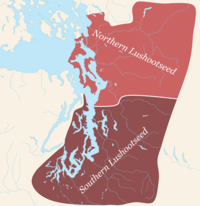
The Muckleshoot Indian Tribe, also known as the Muckleshoot Tribe, is a federally-recognized tribe located in Auburn, Washington. The tribe governs the Muckleshoot Reservation and is composed of descendants of the Duwamish, Stkamish, Smulkamish, Skopamish, Yilalkoamish, and Upper Puyallup peoples. The Muckleshoot Indian Tribe was formally established in 1936, after the Indian Reorganization Act of 1934, but its origins lie in the creation of the Muckleshoot Reservation in 1874 and the treaties of Medicine Creek (1854) and Point Elliott (1855).

The Stillaguamish people are a Southern Coast Salish people Indigenous to the Stillaguamish River valley in northwestern Washington State in the United States, near the city of Arlington, Washington. The Stillaguamish speak Northern Lushootseed, a Coast Salish language. Although usage of the language has declined, there are ongoing revitalization efforts by the Stillaguamish Tribe.

The Tulalip Tribes of Washington, formerly known as the Tulalip Tribes of the Tulalip Reservation, is a federally recognized tribe of Duwamish, Snohomish, Snoqualmie, Skagit, Suiattle, Samish, and Stillaguamish people. They are South and Central Coast Salish peoples of indigenous peoples of the Pacific Northwest Coast. Their tribes are located in the mid-Puget Sound region of Washington.

The Duwamish are a Lushootseed-speaking Southern Coast Salish people in western Washington, and the Indigenous people of metropolitan Seattle.

The Sauk-SuiattleIndian Tribe is a federally-recognized tribe of Sauk people located in western Washington state. The tribe historically lived along the banks of the Sauk, Suiattle, Cascade, Stillaguamish, and Skagit rivers, in the area known as Sauk Prairie at the foot of Whitehorse Mountain in the North Cascade Range.
Lushootseed, historically known as Puget Salish, Puget Sound Salish, or Skagit-Nisqually, is a Central Coast Salish language of the Salishan language family. Lushootseed is the general name for the dialect continuum composed of two main dialects, Northern Lushootseed and Southern Lushootseed, which are further separated into smaller sub-dialects.

The Snohomish people are a Lushootseed-speaking Southern Coast Salish people who are indigenous to the Puget Sound region of Washington State. Most Snohomish are enrolled in the Tulalip Tribes of Washington and reside on the reservation or nearby, although others are enrolled in other tribes, and some are members of the non-recognized Snohomish Tribe of Indians. Traditionally, the Snohomish occupied a wide area of land, including the Snohomish River, parts of Whidbey and Camano Islands, and the nearby coastline of Skagit Bay and Puget Sound. They had at least 25 permanent villages throughout their lands, but in 1855, signed the Treaty of Point Elliott and were relocated to the Tulalip Reservation. Although some moved to the reservation, the harsh conditions, lack of land, and oppressive policies of the United States government caused many to leave.
The Samish are a Native American people who live in the U.S. state of Washington. They are a Central Coast Salish people. Through the years, they were assigned to reservations dominated by other Tribes, for instance, the Swinomish Indians of the Swinomish Reservation of Washington and the Tulalip Tribes of the Tulalip Reservation. They are also enrolled in the Samish Indian Nation, formerly known as the Samish Indian Tribe, which regained federal recognition in 1996.
The Sammamish people are a Lushootseed-speaking Southern Coast Salish people. They are indigenous to the Sammamish River Valley in central King County, Washington. The Sammamish speak Lushootseed, a Coast Salish language which was historically spoken across most of Puget Sound, although its usage today is mostly reserved for cultural and ceremonial practices.

The Upper Skagit Indian Tribe is a federally-recognized Indian tribe located in the U.S. state of Washington. The tribe is the successor-in-interest to approximately eleven historic tribes which had many permanent villages along the Skagit River in what is now Skagit County.
The Lower Skagit are a tribe of the Lushootseed Native American people living in the U.S. state of Washington. Today they are enrolled in the federally recognized tribe, the Swinomish Indians of the Swinomish Reservation.

Snee Oosh is a populated place on Fidalgo Island in the U.S. state of Washington, on the Swinomish Indian Reservation. The population was reported as 302 in 1999.

The Swinomish Indian Tribal Community, also known as the Swinomish Tribe, is a federally recognized tribe located on Puget Sound in Washington state. Swinomish is a legal successor to signatories of the 1855 Treaty of Point Elliott. Its Reservation is located 65 miles North of Seattle, Washington on Fidalgo Island.The tribe's population is primarily composed of Swinomish, Lower Skagit, Kikiallus, and Samish peoples and their descendants. Other populations on the reservation include the Suquamish and Upper Skagit.

The Swinomish Indian Reservation is the reservation of the Swinomish Indian Tribal Community, located on Fidalgo Island in western Washington state. The western boundary of the reservation is disputed between the Swinomish Tribe and the United States government. De facto, the reservation is around 15 square miles in size. It comprises a substantial portion of the eastern portion of Fidalgo Island. The total reservation population in 2000 was 2,664.

The Snoqualmie people are a Lushootseed-speaking Southern Coast Salish people indigenous to the Snoqualmie Valley, located in east King and Snohomish counties in the state of Washington.

The Kikiallus people are a Lushootseed-speaking Coast Salish people Indigenous to parts of western Washington.

The Skykomish are a Lushootseed-speaking Coast Salish people indigenous to the Skykomish Valley in the Cascade Mountains of Washington.

The Puyallup are a Lushootseed-speaking Southern Coast Salish people indigenous to the Puget Sound region of Washington state. They are primarily enrolled in and represented by the Puyallup Tribe of Indians, a federally-recognized Indian tribe located near Tacoma.
The Nuwhaha were a historical Lushootseed-speaking people in the Skagit River valley of Washington. The Nuwhaha primarily lived along the Samish River, as well as the coastal areas between Bay View and Bellingham.


















